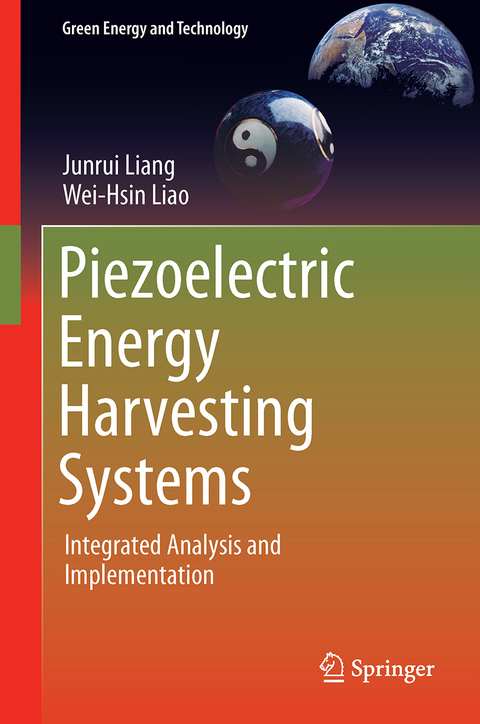
Piezoelectric Energy Harvesting Systems
Springer Berlin (Verlag)
9783662536025 (ISBN)
- Noch nicht erschienen - erscheint am 13.06.2027
- Versandkostenfrei
- Auch auf Rechnung
- Artikel merken
Dr. Junrui Liang received the B.E. and M.E. degrees in Instrumentation Science and Engineering from Shanghai Jiao Tong University, Shanghai, China, in 2004 and 2007, respectively, and the Ph.D. degree in Mechanical and Automation Engineering from The Chinese University of Hong Kong, Hong Kong, in 2010. After obtaining his degrees, he worked at Smart Materials and Structures Laboratory, The Chinese University of Hong Kong and later Centre for Smart Energy Conversion and Utilization Research (previous Centre for Power Electronics), City University of Hong Kong as a postdoctoral researcher. Since Nov. 2013, Dr. Liang has been with School of Information Science and Technology, ShanghaiTech University as an Assistant Professor. Dr. Liang focuses on the research of electrical and electromechanical energy conversion systems. His recent research interests include: kinetic energy harvesting and vibration control, dynamics of nonlinear electromechanical coupling systems, electrical power conversion and utilization research, renewable energy, etc. His most significant contribution was that he extended the impedance modeling and analysis, which conventionally was only used for linear systems, to some nonlinear power conversion systems such as the class-E power amplifier and piezoelectric energy harvesting systems. Based on the extension, efficient analysis and optimization about the transferred power and conversion efficiency were achieved in these systems. In particular, extending the scope of impedance also helps clarify some important but previously overlooked scientific issues for the coupled electromechanical power conversion systems. Since 2008, Dr. Liang has published 19 peer-reviewed technical papers in international journals and conferences. He is a member of IEEE and ASME. He has served as a reviewer of several international journals, and section chair of 2014 SPIE SS/NDE international conference. He was a recipient of Best Student Contributions Award at the 19th International Conference on Adaptive Structures and Technologies in 2008, and two Best Paper Awards at the IEEE International Conference on Information and Automation in 2009 and 2010, respectively. Dr. Liang was also awarded the Postgraduate Research Output Award, which recognized his achievement as one of the most highlighting research outputs done by postgraduates within The Chinese University of Hong Kong in 2010. Dr. Wei-Hsin Liao received his Ph.D. in Mechanical Engineering in May 1997 from The Pennsylvania State University, University Park, USA. At Penn State University, he received the Inventor Incentive Award and Sigma Xi Graduate Research Award. Since August 1997, Dr. Liao has been with the Department of Mechanical and Automation Engineering at The Chinese University of Hong Kong (CUHK), where he is also the founding director of the Smart Materials and Structures Laboratory. Dr. Liao currently serves as the Programme Director, MSc Programme in Biomedical Engineering, Division of Biomedical Engineering. He was the Program Chair for the International Symposium on Smart Structures and Microsystems in 2000, as well as the 2005 IEEE International Conference on Information Acquisition. Since 2000, he has been a member of the International Organizing Committee of the International Conference on Adaptive Structures and Technologies (ICAST). He was the Conference Chair for the 20th ICAST held in Hong Kong in 2009. He is the Conference Co-Chair of the Active and Passive Smart Structures and Integrated Systems, in the SPIE Smart Structures/NDE. Dr. Liao has been a Principal Investigator of several projects supported by the Hong Kong Research Grants Council and Innovation and Technology Commission, Hong Kong Special Administrative Region. His research has led to publications of over 130 technical papers in international journals and conference proceedings, three US patents and four other US patent application
System overview.- State of the art.- Piezoelectricity: modeling from material to structure.- Interface circuits for piezoelectric energy harvesting.- Energy flow in vibration energy harvesting systems.- Integrated analysis based on equivalent impedance network.- Dielectric loss against piezoelectric power harvesting.- Power analysis under different harmonic excitation conditions.- Self-powered switching interface circuit.- Circuit improvements towards higher harvesting capability.- Concluding remarks
| Erscheinungsdatum | 18.07.2025 |
|---|---|
| Reihe/Serie | Green Energy and Technology |
| Zusatzinfo | 300 p. 150 illus., 50 illus. in color. |
| Verlagsort | Berlin |
| Sprache | englisch |
| Maße | 155 x 235 mm |
| Themenwelt | Technik ► Elektrotechnik / Energietechnik |
| Schlagworte | Circuits and Systems • Dielectric Loss • Electrical Engineering • Electromechanically Coupled System • Electronics: circuits and components • Energy • Energy Flow-Integrated Analysis • Energy harvesting • energy technology • Energy technology and engineering • Equivalent Impedance-Switching Interface Circuit • mechanics of solids • Mechatronics • other manufacturing technologies • Piezoelectric Material • Vibration damping • Vibration, Dynamical Systems, Control • wireless sensor network |
| ISBN-13 | 9783662536025 / 9783662536025 |
| Zustand | Neuware |
| Informationen gemäß Produktsicherheitsverordnung (GPSR) | |
| Haben Sie eine Frage zum Produkt? |
aus dem Bereich


